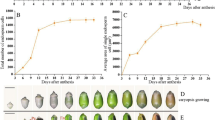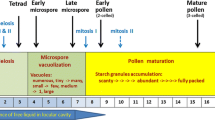Summary
Transfer cells in the nucellar projection of wheat grains at 25 ±3 days after anthesis have been examined using light and electron microscopy. Within the nucellar tissue, a sequential increase in non-polarized wall ingrowth differentiation and cytoplasmic density was evident. Cells located near the pigment strand were the least differentiated. The degree of differentiation increased progressively in cells further removed from the pigment strand and the cells bordering the endosperm cavity had degenerated. Four stages of transfer cell development were identified at the light microscope level. Wall ingrowth differentiation followed a sequence from a papillate form through increased branching (antler-shaped ingrowths) which ultimately anastomosed to form a complex labyrinth. The final stage of wall ingrowth differentiation was compression which resulted in massive ingrowths. In parallel with wall ingrowth deposition cytoplasmic density increased. During wall deposition, paramural and multivesicular bodies were prominent and were in close association with the wall ingrowths. The degeneration phase involved infilling of cytoplasmic islets within the wall ingrowths. This was accompanied by complete loss of the protoplast. The significance of this transfer cell development for sucrose efflux to the endosperm cavity was assessed by computing potential sucrose fluxes across the plasma membrane surface areas of the nucellar projection cells. Transfer cell development amplified the total plasma membrane surface area by 22 fold. The potential sucrose flux, when compared with maximal rates of facilitated membrane transport of sugars, indicated spare capacity for sucrose efflux to the endosperm cavity. Indeed, when the total flux was partitioned between the nucellar projection cells at the three stages of transfer cell development, the fully differentiated stage III cells located proximally to the endosperm cavity alone exhibited spare transport capacity. Stage II cells could accommodate the total rate of sucrose transfer, but stage I cells could not. It is concluded that the nucellar projection tissue of wheat provides a unique opportunity to study transfer cell development and the functional role of these cells in supporting sucrose transport.
Similar content being viewed by others
Abbreviations
- CSPMSA:
-
cross sectional plasma membrane surface area
- LPMSA:
-
longitudinal plasma membrane surface area
- PTS:
-
tri-sodium 3-hydroxy-5,8,10-pyrenetrisulfonate
References
Bonnemain JL, Bourquin S, Renault S, Offler CE, Fisher DG (1991) Transfer cells: structure and physiology. In: Bonnemain JL, Delrot S, Lucas WJ, Dainty J (eds) Recent advances in phloem transport and assimilate compartmentation. Ouest Editions, Paris, pp 74–83
Bray DF, Wagener EB (1978) A double staining technique for improved contrast of thin sections from Spurr-embedded tissue. Can J Bot 56: 129–132
Bremner PM, Rawson HM (1978) The weights of individual grains of the wheat ear in relation to their growth potential, the supply of assimilate and interaction between grain. Aust J Plant Physiol 5: 61–72
Browning AJ, Gunning BES (1979) Structure and function of transfer cells in the sporophyte haustorium ofFunaria hygrometrica Hedw. J Exp Bot 30: 1233–1246
Chrispeels MJ (1980) The endoplasmic reticulum. In: Tolbert NE (ed) The biochemistry of plants, a comprehensive treatise, vol 1. Academic Press, New York, pp 389–412
Cochrane MP (1983) Morphology of the crease region in relation to assimilate uptake and water loss during caryopsis development in barley and wheat. Aust J Plant Physiol 10: 473–491
—, Duffus CM (1980) The nucellar projection and modified aleurone in the crease region of developing caryopses of barley (Hordeum vulgare L. var.distichum). Protoplasma 103: 361–375
Davis RW, Smith JD, Cobb CB (1990) A light and electron microscope investigation of the transfer cell region of maize caryopses. Can J Bot 68: 471–479
Esau K, Cheadle VI, Gill RH (1966) Cytology of differentiating tracherary elements I. Organelles and membrane systems. Amer J Bot 53: 756–764
Felker FC, Shannon JC (1980) Movement of14 C-labeled assimilates into kernels ofZea mays L. III. An anatomical examination and microautoradiographic study of assimilate transfer. Plant Physiol 65: 864–870
Grimes HD, Overvoorde PJ, Ripp K, Franceschi VR, Hitz WD (1992) A 62 kD sucrose binding protein is expressed and localized in tissues actively engaged in sucrose transport. Plant Cell 4: 1561–1574
Gunning BES (1977) Transfer cells and their roles in transport of solutes in plants. Sci Prog 64: 539–568
—, Pate JS (1974) Transfer cells. In: Robards AW (eds) Dynamic aspects of plant ultrastructure. McGraw-Hill, London, pp 441–480
Jones MGK, Dropkin VH (1976) Scanning electron microscopy of nematode induced giant transfer cells. CytoBios 15: 58–59
Landsberg EC (1986) Function of rhizodermal transfer cells in the iron stress response mechanism ofCapsicum annuum. Plant Physiol 82: 511–517
Lüttge U, Higinbotham N (1979) Transport in plants. Springer, Berlin Heidelberg New York
Maness MO, McBee GG (1986) Role of placental sac in endosperm carbohydrate import inSorghum bicolor caryopses. Crop Sci 26: 1201–1207
Marchant R, Robards AW (1968) Membrane systems associated with the plasmalemma of plant cells. Ann Bot 32: 457–471
Newcomb W, Peterson RL (1979) The occurrence and ontogeny of transfer cells associated with lateral roots and root nodules inLeguminosae. Can J Bot 57: 2583–2602
Offler CE, Patrick JW (1993) Pathway of photosynthate transfer in the developing seed ofVicia faba L.: a structural assessment of the role of transfer cells in unloading from the seed coat. J Exp Bot 44: 711–724
—, Nerlich SM, Patrick JW (1989) Pathway of photosynthate transfer in the developing seed ofVicia faba L. I. Transfer in relation to seed anatomy. J Exp Bot 40: 769–780
Overall RL, Wolfe J, Gunning BES (1982) Intercellular communication inAzolla roots: I. Ultrastructure of plasmodesmata. Protoplasma 111: 134–150
Park P, Yamamoto S, Kohmoto K, Otan H (1982) Comparative effects of fixation methods using tannic acid on contrast of stained and unstained sections from Spurr-embedded plant leaves. Can J Bot 60: 1769–1804
Pate JS, Gunning BES (1969) Vascular transfer cells in angiosperm leaves: a taxonomic and morphological survey. Protoplasma 68: 135–156
— — (1972) Transfer cells. Annu Rev Plant Physiol 23: 173–196
Rost TL, Lersten NR (1970) Transfer aleurone cells inSetaria lutescens (Graminae). Protoplasma 71: 403–408
—, Izaguirre de Artucio P, Risley EB (1984) Transfer cells in the placental pad and caryopsis coat ofPappophorum subbulbosum Arech. (Poaceae). Amer J Bot 71: 948–957
Sofield I, Evans LT, Cook MG, Wardlaw IF (1977) Factors influencing the rate and duration of grain filling in wheat. Aust J Plant Physiol 4: 785–797
Spurr AR (1969) A low-viscosity epoxy resin embedding medium for electron microscopy. J Ultrastruct Res 26: 31–43
Tripathi S, Boulpaep E (1989) Mechanisms of water transport by epithelial cells. Q J Exp Physiol 74: 385–417
Wang HL, Patrick JW, Offler CE, Wardlaw IF (1993) A novel experimental system for studies of photosynthate transfer in the developing wheat grain. J Exp Bot 44: 1177–1184
- Offler CE, Patrick JW (1994 a) The cellular pathway of photosynthate transfer in the developing wheat grain. II. A structural analysis and histochemical studies of the transfer pathway from the crease phloem to the endosperm cavity. Plant Cell Environ (in press)
— — —, Ugalde TD (1994 b) The cellular pathway of photosynthate transfer in the developing wheat grain. I. Delineation of a potential transfer pathway using fluorescent dyes. Plant Cell Environ 17: 257–266
Wimmers LE, Turgeon R (1991) Transfer cells and solute uptake in minor veins ofPisum sativum leaves. Planta 186: 2–12
Zees S, O'Bries TP (1971) Aleurone transfer cells and other structural features of the spikelet of millet. Aust J Biol Sci 24: 391–395
Author information
Authors and Affiliations
Rights and permissions
About this article
Cite this article
Wang, H.L., Offler, C.E. & Patrick, J.W. Nucellar projection transfer cells in the developing wheat grain. Protoplasma 182, 39–52 (1994). https://doi.org/10.1007/BF01403687
Received:
Accepted:
Issue Date:
DOI: https://doi.org/10.1007/BF01403687




